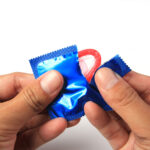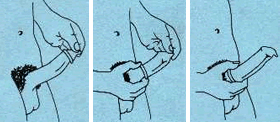 Great question! First, you and your partner will need to learn how to use condoms correctly. This begins with opening up the condom wrapper with care.
Great question! First, you and your partner will need to learn how to use condoms correctly. This begins with opening up the condom wrapper with care.
- Open the wrapper carefully: Be careful when opening a condom package so that you don’t tear or nick the latex with your teeth, nails, or rings. Don’t unroll the condom before putting it on the penis, because it can weaken the latex and make the condom tough to use.
- Once the condom is out of the wrapper: Gently press out air at the tip of the condom. Make sure to leave space at the tip (about one-half inch) to collect the semen, so it won’t leak out the side of the condom.
- Use a water-based lube: You can use a water-based lubricant (such as glycerin or lubricating jelly) during intercourse to prevent condoms from breaking. If you put a drop of lubricant (such as KY-Jelly) inside the tip of the condom, you can increase both sensation and safety.
- Never use an oil-based lubricant, since it will weaken the latex and cause it to break. Examples of oil-based lubricants include Crisco, lotion, Vaseline, or baby oil.
- Putting the condom on: You can put a condom on a guy, or he can put it on himself. If you’re putting the condom on your partner, hold the tip of the condom between your thumb and forefinger against the head of his penis. Put the condom on when his penis is erect (hard). If his penis is uncircumcised, pull back the foreskin before putting on the condom. Unroll the condom over the entire length of his erect penis.

Taking the condom off: After a guy has ejaculated (released sperm), he should pull out while his penis is still hard, since the condom can easily slip off when the erection is lost (when the penis becomes soft again). He should hold the condom at the base of his penis while withdrawing so semen doesn’t spill out. Then he should gently roll the condom toward the tip of his penis to take it off.
Lastly, you should wrap the used condom in a tissue and throw it out in the trash. Don’t flush it down the toilet, since it can clog it.
Our health guides are developed through a systematic, rigorous process to ensure accuracy, reliability, and trustworthiness. Written and reviewed by experienced healthcare clinicians from Boston Children's Hospital, a Harvard Medical School teaching hospital and consistently ranked as a top hospital by Newsweek and U.S. News & World Report, these guides combine clinical expertise, specialized knowledge, and evidence-based medicine. We also incorporate research and best practices from authoritative sources such as the CDC, NIH, PubMed, top medical journals, and UpToDate.com. Clinical specialists and subject matter experts review and edit each guide, reinforcing our commitment to high-quality, factual, scientifically accurate health information for young people.